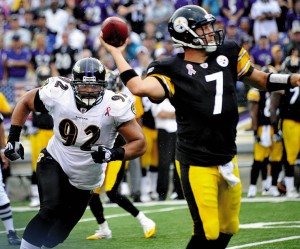Considering Maryland took a week off last week, I think I’ll take a week off from writing about them. See if they can handle Towson at home, and then I’ll try to reattach the axles to the Maryland bandwagon
First and foremost I’m a New York Jets fan, and they’ll be playing about two blocks from my house on Sunday. So let’s get to breaking down a game between two of the top contenders in the AFC behind the standard of excellence, the Buffalo Bills.
Why the Ravens should win this game:
In their two wins, the Ravens have been dominant, outscoring Pittsburgh and St. Louis by a combined 72-14. Obviously, the Steelers win is going to continue to look better as Pittsburgh continues to round into form, while the Rams win could depreciate for the opposite reason.
They’ve looked like a better team in the first three weeks than the Jets. Even their lone loss doesn’t look as bad, with the Titans playing like a legitimate contender until Kenny Britt’s leg exploded last week. If I had to break it down position by position, the only spots that I could definitively give to the Jets would be defensive backs, and offensive line if Nick Mangold is healthy this week.
Specifically, The Ravens offensive personnel could be a particularly difficult matchup for the Jets if Cam Cameron plays his cards right. Looking into DVOA, the Jets are unsurprisingly the best in the league at holding #1 receivers in check, but from there it becomes somewhat murky. The 8th in league rank vs. #2 receivers could take a hit this week considering that either A) Cromartie will be playing with a bruised lung, or B) Kyle Wilson will be face a major step up in competition.
The weakness of the Jets pass defense lies in their coverage of tight ends (25th in DVOA). Jason Witten had 6 catches for 110 yards in week 1, and even Kevin Boss had a 28-yard catch last week. The Jets two starters at safety are undersized (Jim Leonhard), and shaky in coverage (Eric Smith) respectably. Even if Brodney Pool makes the occasional appearance, this week is the perfect time for the Ravens to unleash Dickson and Pitta over the middle.
Obviously the most obvious plan of attack for the Ravens would be pounding it out on the ground after seeing what happened last week against Oakland. But bear in mind two things: Darren McFadden is possibly the best running back in the NFL at this point, and this is almost the same defense that shut down Ray Rice last year (21 carries, 43 yards). As a Jets fan, I have to think that the strategy will be to keep the best player (Rice) from making a huge impact, and making Flacco win this game. If he stays away from Revis, and works on Cromartie and the tight ends, he should have an efficient, productive day on the way to a Ravens win.
Why the Jets should win this game:
Flacco and Sanchez aren’t separated by much this year. They’re 12th and 13th respectively in DVOA and DVAR, which measures how much better they’ve been than an average NFL quarterback. Flacco has more TD’s and fewer picks, but so far this season, Sanchez’s completion percentage is demonstrably higher (62.5 to 54.1). That number tells me that Flacco has dodged a few bullets this year with his inaccuracy, and an opportunistic Jets defense could jump on those (see the Jacksonville game).
Flacco has been outstanding out of the gates this year, going a combined 17/28 for 295 yards and 4 TD in 3 first quarters. But as you can guess by looking at his season stats, that means a disproportionate amount of Flacco’s production has come early in games. Although the Ravens have essentially put away two of their three games before halftime, Flacco is still only a 50% passer (22/44) with a TD and an INT in second halves this year.
Sanchez has been completely the opposite, completing 20/33 passes in 3 fourth quarters this year, and throwing 4 of his 6 touchdowns after halftime. What this all comes down to is that Sanchez has crunch time reps, and it’s accurate to say that he excels late in games. Could Flacco if he was put in the same situation? I don’t necessarily think so, considering he hasn’t thrown a 4th quarter touchdown since Week 10 of last year. So if this game is close late, I think the advantage swings heavily towards New York.
To win Sanchez needs to establish Holmes and Burress. The Ravens should do a very good job of taking away Dustin Keller and LaDainian Tomlinson (3rd in DVOA vs. tight ends, 5th in DVOA vs. running backs). The Ravens struggle on the outside of their defense, where Cary Williams and LaDarius Webb are two subpar corners who have had a lot of trouble containing big time receivers like Kenny Britt and Mike Wallace. Holmes has shown in the past two years that he’s capable of going off for a big game against an overmatched corner.
So I expect the Ravens to shift the coverage towards him, leaving Plaxico Burress in a lot of single coverage over on the other side. Mark my words, if Plax has a big day (say 6 catches for 80 yards and a TD), the Jets will win this game. With him producing, the Ravens can disguise coverages as much as they want, the Jets will just have too much firepower against an average Ravens secondary.
Ravens win if
Ray Rice gets over 150 total yards and a TD
Plaxico Burress has under 60 yards receiving
Flacco’s completion percentage over 60%
Jets win if:
The game is within 7 points going into the 4th quarter
Plaxico Burress has over 80 yards and a TD
LaDainian Tomlinson over 100 all-purpose yards and a TD
Ravens score 14 points or less in the first half









